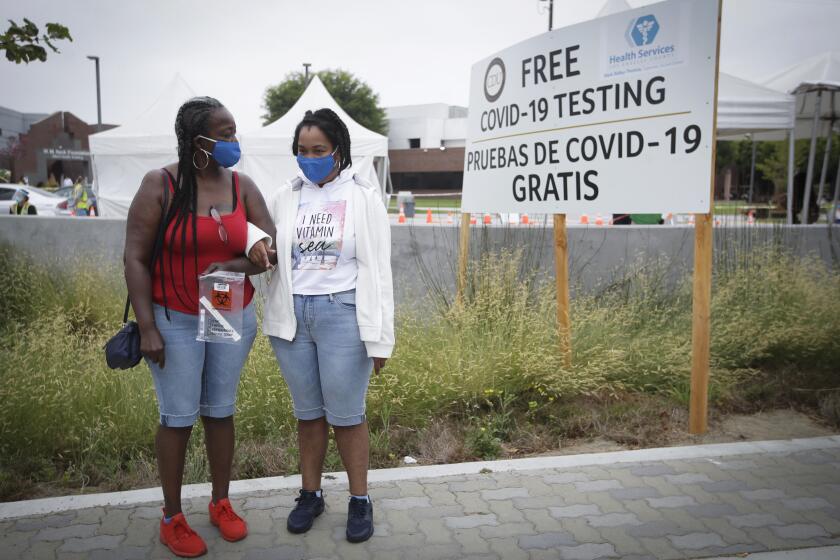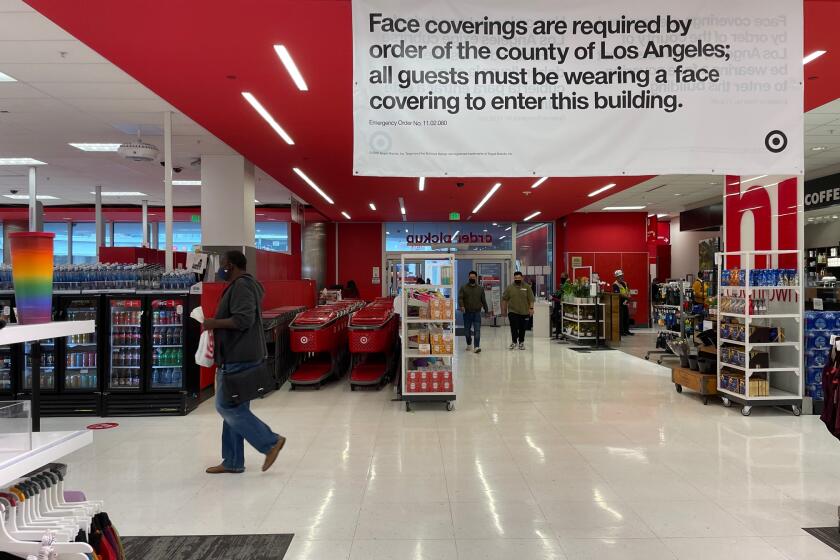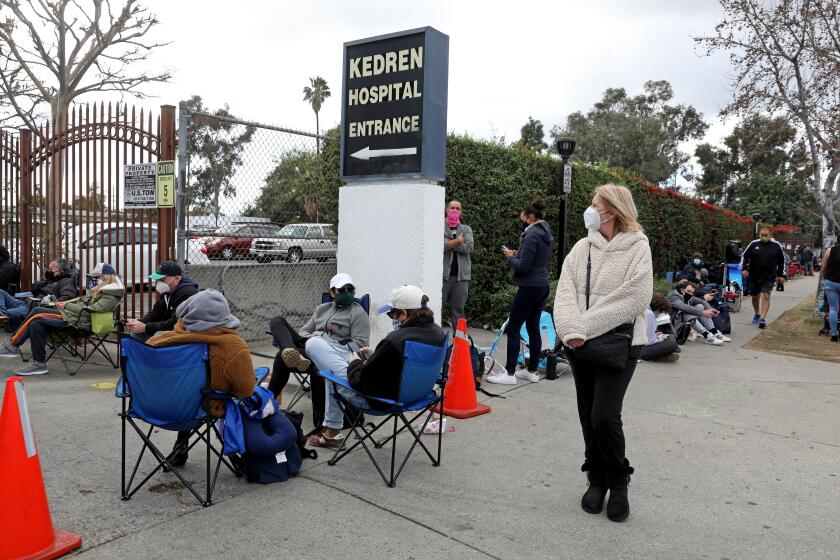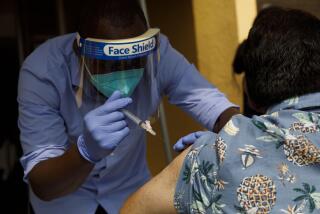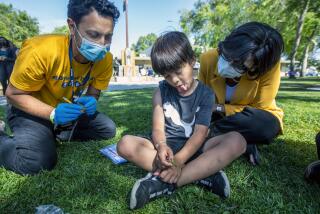Column: Ready to ditch your mask? South L.A. is proof the pandemic isn’t over yet
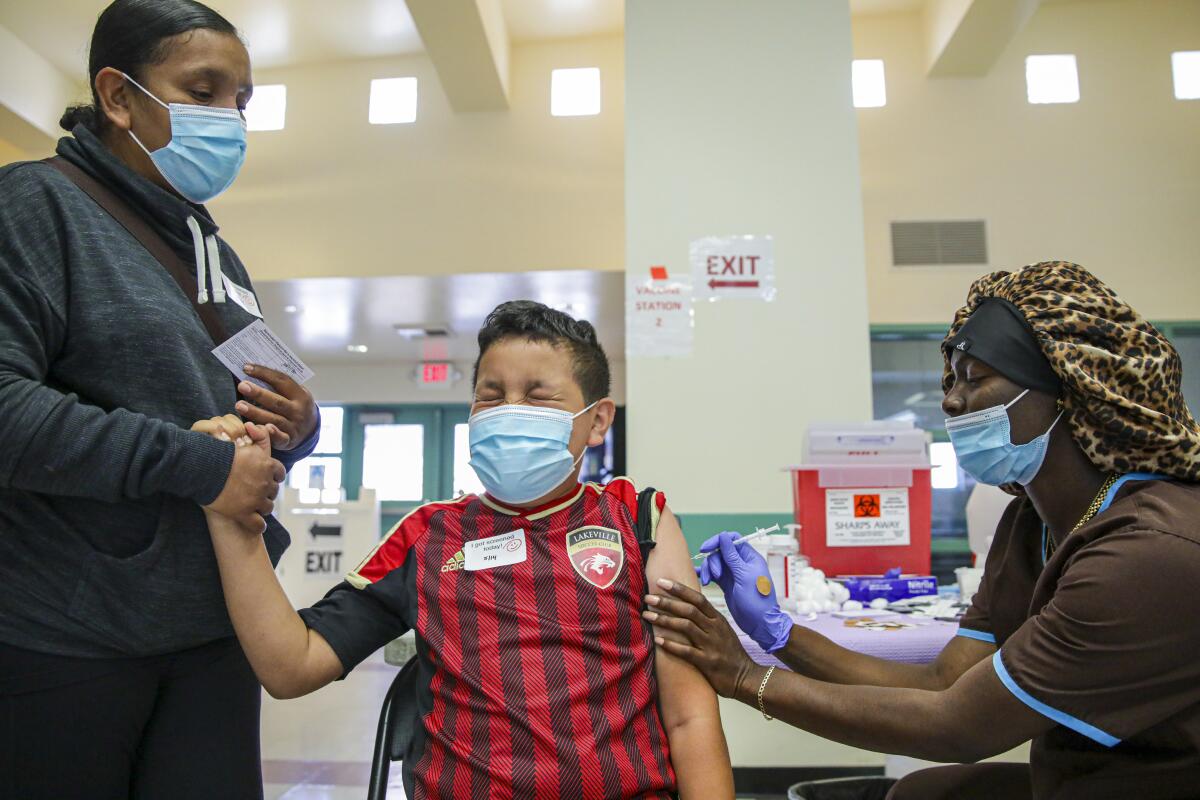
Remember back at the beginning of the COVID-19 pandemic, when no one could escape those insipid public service announcements proclaiming that “we’re all in this together”?
It wasn’t true then. And, in many ways, it’s even less true now.
On Monday, California’s secretary of Health and Human Services, Dr. Mark Ghaly, announced that come June 15, people who are fully vaccinated will no longer have to wear face masks in most places, whether they are indoors or outdoors.
It’s a decision that will put the state in line — albeit belatedly — with guidance from the Centers for Disease Control and Prevention, which last week changed its mask advice, prompting mass confusion and consternation.
“It’s really just giving ourselves across the state some additional time to have it implemented with a high degree of integrity, with a continued focus on protecting the public,” Ghaly said during a press briefing.
The thinking, he explained, is that people who remain unvaccinated for one reason or another might change their minds once they see “a little less masking out in our communities.” California also plans to fully reopen its economy on June 15.
For years, the faculty of Charles R. Drew University has built trust in South L.A. It’s the best chance of beating hesitancy about the COVID-19 vaccine.
That’s not quite the way Dr. Amon Rodgers thinks about it.
For months, the assistant professor at Charles R. Drew University of Medicine and Science in South Los Angeles has been trying to get as many people — particularly people of color — vaccinated as possible.
It’s been a slow process. And the results have been uneven.
Despite all of the congratulations politicians gave themselves for improving the equitable distribution of vaccines, there are still disparities and they are still wide.
According to a Times analysis of 15 South L.A. Zip Codes last week, only about 26% of the 830,000 residents there are fully vaccinated for COVID-19, and only about 38% have received one dose.
Get the latest from Erika D. Smith
Commentary on people, politics and the quest for a more equitable California.
You may occasionally receive promotional content from the Los Angeles Times.
Compare to Los Angeles County, as a whole, where 36% of residents are fully vaccinated and about 49% have received one dose, according to the analysis. Statewide, 39% of Californians are fully vaccinated and 51% have received at least one dose of a COVID-19 vaccine.
By race, the percentages are even more stark.
Statewide, 65% of Black and 66% of Latino Californians haven’t been vaccinated, while just 49% of white and 38% of Asian Californians have not, according to The Times’ vaccination tracker.
Countywide, an appalling 68% of Black residents and 67% of Latino residents have yet to receive a single shot, compared to 46% of white and 38% of Asian residents, according to the Times analysis.
Having this many unvaccinated, potentially unmasked people walking around — many of whom are essential workers — doesn’t bode well for keeping our coronavirus cases and deaths near record lows.
“My concern is that the reopening happens before we get a higher rate of vaccinations in areas like Compton and South L.A.,” Rodgers said. “I don’t want this community to be left holding the bag and widening the disparity that we already have.”
And I fear there’s a good chance that will happen, despite Ghaly’s vow on Monday that public health officials would use the weeks leading up to June 15 to work on “delivering vaccines, particularly in underserved communities.”
A backlash against easing mask rules prompts California to slow down
To understand why, I joined Rodgers at Gonzales Park in Compton on Saturday. He and others with Charles R. Drew University had set up the first of what will become a weekly pop-up vaccination site — the only one for miles.
If you think the low vaccination rates aren’t about access to vaccines, you’re only half right. Los Angeles County, like most counties in California, is flush with vials of Pfizer, Moderna and Johnson & Johnson. But some people, particularly those without internet access or vehicles, still have a hard time finding a place to get the jab.
Throughout the afternoon, people, young and old, most of them Black and Latino, trickled into the site at Gonzales Park. Most said they heard about it on the radio.
Erika Taylor, who works for the Los Angeles County Sheriff’s Department, said she had been waiting a while to get vaccinated, but finally decided to get the Johnson & Johnson one-shot formula. She didn’t want to deal with the hassle of two doses.
“A lot of our people are still skeptical,” said Taylor, who is Black. “And that’s fine. You know, if you don’t want to do something, I’m not going talk anybody into doing something.”
Indeed, she left her son in the car. At 12 years old, he’s eligible, but wasn’t interested yet.
Rodgers heard the same thing from a group of maskless Black men gathered for a barbecue at Gonzales Park. “They said,” he recounted, “we ain’t talking about no vaccines.”
Dr. Roberto Vargas, an assistant dean of health policy and inter-professional education at Charles R. Drew University, said a big part of the problem is that many Black and Latino residents of South L.A. don’t have a primary care physician.
“If you’ve never had access to care,” he said, “you can’t have a one-on-one conversation with a healthcare provider to answer your questions.”
Another problem is that many people, particularly those who work two or three jobs, don’t have the time to get vaccinated — or deal with the side effects.
A recent survey from the Kaiser Family Foundation found that Latino adults were twice as likely as white adults to say they wanted to get a COVID-19 vaccine as soon as possible. But many Latino adults also reported that they hadn’t yet because they were worried about missing work and were worried about finding a vaccination site they could trust with their immigration status.
While politicians are discussing ways to make sure more Black and Latino Angelenos get vaccinated, Kedren Health in South L.A. is already doing that.
These are the real and complicated reasons why there are ongoing disparities in vaccine distribution — and why there likely will continue to be after June 15, when people in wealthier neighborhoods move on with life as if the pandemic were over.
We’re not all in this together. And I’m not sure the motivation to be able to ditch one’s face mask is going to change anything — especially when there’s nothing to stop unvaccinated people from abandoning their masks as well (assuming they ever wore them).
Then again, I did meet Willie Hicks. Leaning on his cane, he hobbled into the vaccination site at Gonzales Park on Saturday. He told me that he didn’t think he needed to get the jab. But he figured he would have to do it and be able to prove it eventually. He hadn’t heard about the new honor system guidance on face masks.
“You’re not gonna be able to do things if you don’t have a shot,” Hicks reasoned. “Then the people that take the shot, they don’t want to be with the people that ain’t got the shots.”
More to Read
Get the latest from Erika D. Smith
Commentary on people, politics and the quest for a more equitable California.
You may occasionally receive promotional content from the Los Angeles Times.
